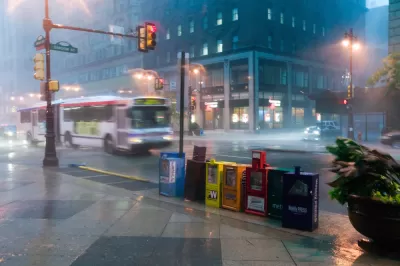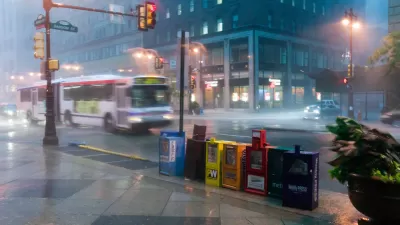Philadelphia is one of many American cities suddenly beset with declining bus ridership numbers, likely in part as a result of the popularity of transportation network companies.

Jason Laughlin reports on shifting transportation mode choice in Philadelphia, where the arrival of transportation network companies in 2014 preceded a sudden drop in bus ridership.
SEPTA’s 123 bus and trolley routes lost about 4.4 million ride trips from fiscal years 2014 to 2016, the agency reported, which mirrors shrinking bus ridership nationwide, according to the American Public Transportation Association. The region’s bus ridership by linked trips in fiscal year 2016 was 114 million, the lowest it had been since 2003.
Moreover,
Compared with 2013, the last full year SEPTA operated without ride sharing in the city, the 2016 ridership loss is even more significant. Last year’s more than 161 million ride trips on both buses and trolleys was about 14 million shy of the ridership three years earlier.
In the face of such a sudden drop in ridership, SEPTA has hired Jarret Walker's firm to evaluate the region's bus system, including the creation of a two-year plan to redesign the bus system.
FULL STORY: As Uber grows, SEPTA to rethink bus service

Alabama: Trump Terminates Settlements for Black Communities Harmed By Raw Sewage
Trump deemed the landmark civil rights agreement “illegal DEI and environmental justice policy.”

Study: Maui’s Plan to Convert Vacation Rentals to Long-Term Housing Could Cause Nearly $1 Billion Economic Loss
The plan would reduce visitor accommodation by 25% resulting in 1,900 jobs lost.

Why Should We Subsidize Public Transportation?
Many public transit agencies face financial stress due to rising costs, declining fare revenue, and declining subsidies. Transit advocates must provide a strong business case for increasing public transit funding.

Wind Energy on the Rise Despite Federal Policy Reversal
The Trump administration is revoking federal support for renewable energy, but demand for new projects continues unabated.

Passengers Flock to Caltrain After Electrification
The new electric trains are running faster and more reliably, leading to strong ridership growth on the Bay Area rail system.

Texas Churches Rally Behind ‘Yes in God’s Back Yard’ Legislation
Religious leaders want the state to reduce zoning regulations to streamline leasing church-owned land to housing developers.
Urban Design for Planners 1: Software Tools
This six-course series explores essential urban design concepts using open source software and equips planners with the tools they need to participate fully in the urban design process.
Planning for Universal Design
Learn the tools for implementing Universal Design in planning regulations.
Caltrans
Smith Gee Studio
Institute for Housing and Urban Development Studies (IHS)
City of Grandview
Harvard GSD Executive Education
Toledo-Lucas County Plan Commissions
Salt Lake City
NYU Wagner Graduate School of Public Service





























